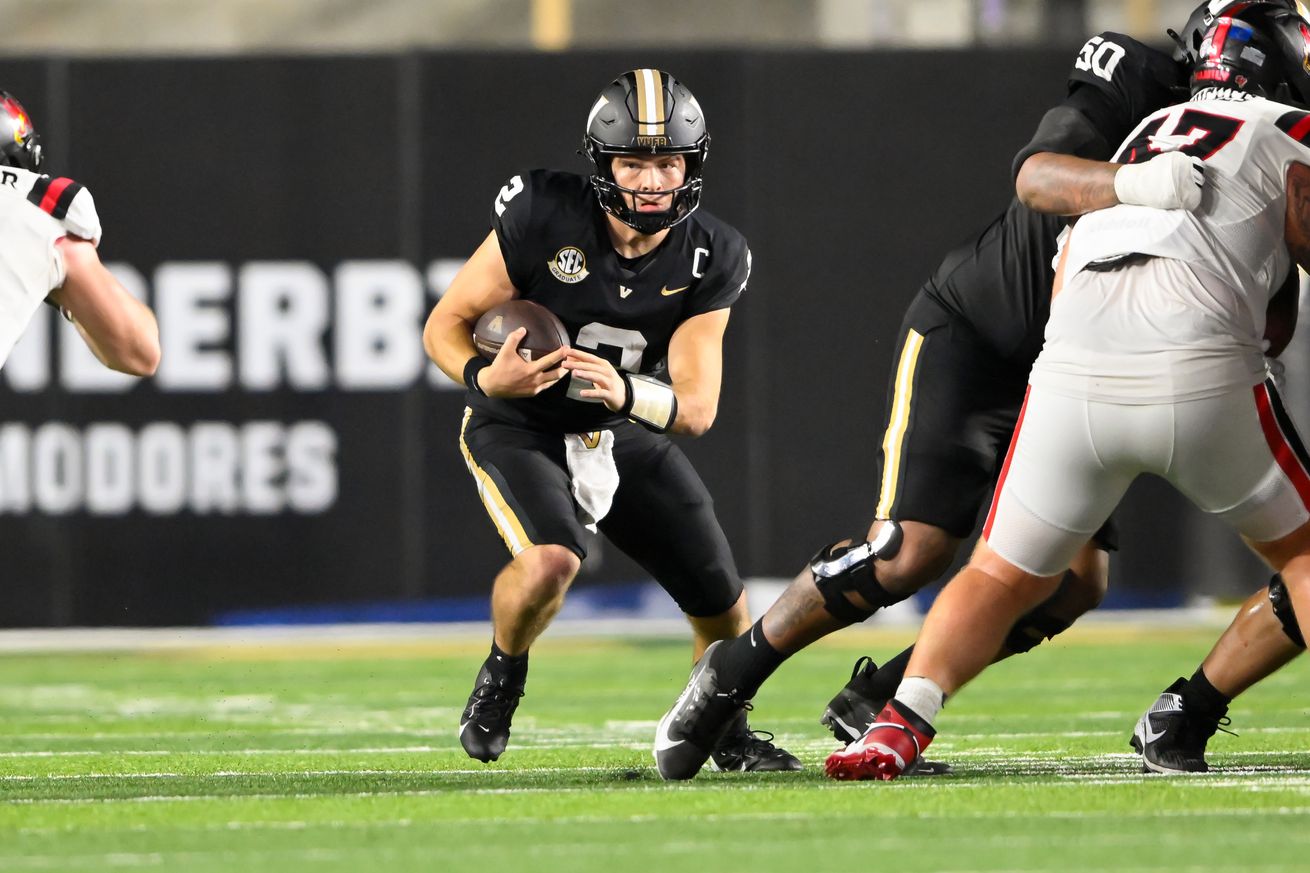
How the Horns match up with the Commodores.
The No. 5 Texas Longhorns are coming off their first loss of the season. As disappointing as the offense seemed out there, in the most packed Darrell K Royal-Texas Memorial Stadium has ever been, we were always hoping the Horns would only suffer one loss between Oklahoma, Georgia, and Texas A&M this year. Moving forward, they have the ability to run the table, though that stretch looks more competent than anticipated, starting with the No. 25 Vanderbilt Commodores in Nashville on Saturday.
Offense
Last week, I emphasized Carson Beck’s struggle under pressure which he has seldom seen this year so far. Georgia’s injured offensive line was able to hold up better than that of Texas. The Horns severely struggled to be able to protect Quinn Ewers or Arch Manning the entire game, giving up seven total sacks. Georgia was ruthless in their choice to send extra guys, with the tradeoff working to perfection, generating enough pressure to where the gaps in coverage were negligible given Ewers’ time to throw. According to PFF, only two of the sacks ended up being attributed to members of the offensive line, but below is a graph displaying the snap breakdown of passing plays.
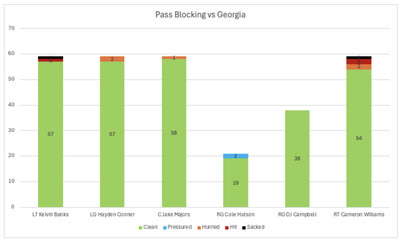
Below are the PPA and usage metrics for the entire team from last weekend.

Vanderbilt is pretty solid at stopping the run, ranking 38th in yards allowed on the ground per game. Defensive end Aeneas DiCosmo (13 tackles, 12 stops) is their best prospect in this facet, followed by defensive tackles Glenn Seabrooks (11, 5) and Christian James (8, 7). Miles Capers (12, 11) has played the most snaps for them at the Razor position (very similar to an edge rusher/strong linebacker who can track the tight end). Following behind them, their linebacker unit has the cohesive strength to back up their line. This consists of will LB Bryan Longwell (18, 10), plus mikes Langston Patterson (19, 13) and Nick Rinaldi (6, 5).
The pass rush is definitely a weaker point for Vanderbilt and should allow the Texas offensive line some breathing room for this weekend. Their best player so far this season was defensive end Khordae Sydnor (2 sacks). Following him were the aforementioned Capers (1.5) as well as Linus Zunk (1.5) on the other edge, both of whom are questionable going into this game. Expect them to send linebackers Rinaldi (3) and Randon Fontenette (1) for extra pressure if they can’t produce any with their front four.
In pass coverage, their corners don’t really have the best play but their starting safety duo consisting of strong safety CJ Taylor (1 pass breakup, 1 interception) and free safety De’Rickey Wright (2, 1), should not be overlooked. Vandy ranks 69th in the nation in pass yards allowed per game.
Both
Explosive Margin has received much coverage this year as a tool to gain edges on spreads. I wanted to discuss it further as Texas ranks amongst the upper echelon of teams and showcase how it can be fact checked against a team’s strength of schedule. An explosive play is a rush over 12 yards or a pass over 20. The margin is simply taking the number of explosive plays generated on offense and subtracting explosive plays allowed on defense. The strength of schedule score is per Team Rankings.com through Week Eight.
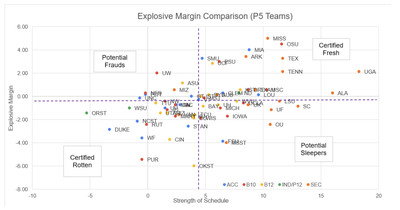
To provide further detail on the margin, I have the details below for the top 10 teams by margin in the FBS currently. This is broken down by the number of plays per game in each category.
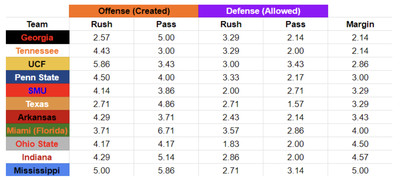
You’ll notice that Texas is still a serious contender. The weakest area for the Horns compared to other teams at their tier is in the run game. They still struggle to create explosive opportunities on the ground, seeing as many as they limit on the other side of the ball ,which is sixth best in the nation. Yet again, the secondary gets to boast their incredible coverage, only allowing 1.57 explosive plays per game through the air. This ranks third best behind Washington and Minnesota, both against weaker schedules.
Defense
The Texas defense still stands strong. Jahdae Barron had two interceptions, plus Andrew Mukuba had one. Mukuba is still questionable going into this weekend, so expect Jelani McDonald to take his place alongside Michael Taaffe as a starting safety.
Vanderbilt is a run-heavy offense, running the ball 61.96 percent of the time (12th highest among 134 FBS teams), meanwhile Texas is at 49.4 percent (91st). There is virtually no gap that they will shy away from, giving a high volume of attempts to either their QB Diego Pavia or RB1 Sedrick Alexander. Below are the rushing splits by direction/gap for the Commodores. The gaps read as if you were viewing the offensive line:
JSL : jet sweep left
LE: off the tight end on the left
LT: off the left tackle, or between tackle and tight end
LG: between the left tackle and guard
ML: between the left guard and center
A slight difference I’ve made from previous renditions of this graph is that the y-axis now measures yards per carry as opposed to total yards, with the labels above each bar displaying the number of attempts.
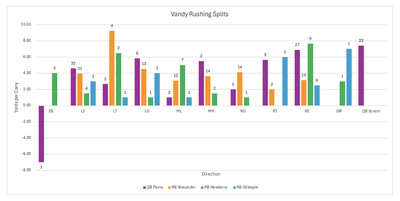
They love the ends the most, often using the read option to exploit edge rushers over committing to Alexander. I expect the linebackers, Anthony Hill Jr, David Gbenda, and Liona Lefau to be reliable in reading the backfield and making sure the runs don’t break out into the second level.
Vanderbilt by most metrics, isn’t the best team with the ball on the ground, despite how much they rely on it. However, they currently generate the same number of explosive plays on the ground as Texas at 2.71 per game. This doesn’t necessarily mean anything as Georgia had trouble running the ball all year, but Trevor Etienne slowly ate through the Texas front during the second half of the game, racking up three touchdowns along the way.
The Longhorns ability to stop the run seemed to be gaining momentum throughout the year, with an impressive performance against Michigan, and their best coming against Mississippi State. But Oklahoma and Georgia were able to undo that quickly with most of the Horns’ explosive runs allowed coming from those two games. Below is a distribution on the number of yards allowed per run against each team this year.
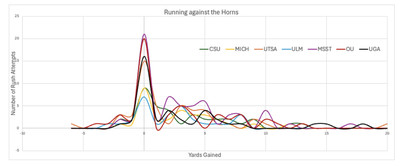
In their backfield, Sedrick Alexander is their do-it-all guy who can also be a pass-catching option. Referring back to the run splits graph, he has been reliable as a force through any and every gap. AJ Newberry is a bit leaner in size and has found his best success on the outside with his speed. Chase Gillespie has received a significant number of snaps so far this season, but they may need to lean on him this weekend as Alexander and Newberry are both still listed as questionable on the injury report.
In passing situations, tight end Eli Stowers is Pavia’s favorite target, often finding him over the middle of the field or using him in screens breaking away from the o-line. In these areas he is a combined 20-of-22 passing and tallied two touchdowns. Wide out Quincy Skinner Jr. is their most well-rounded guy and is often used in the medium game given his route-running abilities while Junior Sherrill is left to be the one true deep option. Sherrill has struggled only hauling 2-of-8 catches in the 20-plus yard range. Below are the PPA and usage metrics for the Commodores for the year.

Conclusion
We cannot take anything else for granted with the rest of the schedule. Texas A&M looks like the toughest remaining game, and they are currently 4-0 in conference play. Another loss would make it really difficult to see the Horns at Mercedes Benz for the SEC Championship, let alone a natty. Vandy, Kentucky, Arkansas have all beaten top-tier teams so far this year, and Florida is slowly recovering from a shaky start.
The Horns desperately need a bounce back game offensively in which Ewers can assure us he still has the deep ball play in him. We hope to see more of Isaiah Bond again and I wouldn’t mind a transition to Quintrevion Wisner as the bell cow with Jaydon Blue being used as the predominant receiving back. The Texas defensive backs could be the Blue Angels the way they shut down the air. It will be up to the defensive front to make the Vandy run game uncomfortable and force them into looking elsewhere. If they can’t make those stops in the first half, the Commodores could even eat through the deep defensive line rotation we have boasted about before. The current spread is -18.5 and we need to see the Horns cover if they wish to retain their top-five status.